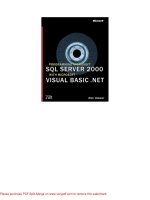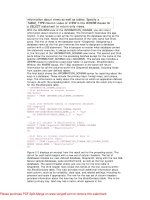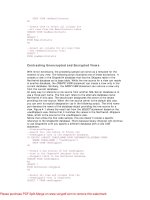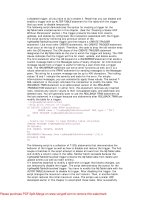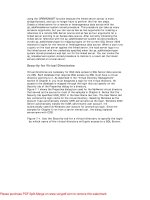microsoft visual basic 2015 chapter 11
Bạn đang xem bản rút gọn của tài liệu. Xem và tải ngay bản đầy đủ của tài liệu tại đây (2.49 MB, 47 trang )
Microsoft Visual Basic 2015
CHAPTER ELEVEN
Multiple Classes
and Inheritance
11
Objectives
►Use the TabIndex Property
►Edit input, including MaskedTextBox,TextBox, and
ComboBox objects
►Describe the three-tiered program structure
►Understand a class
►Create a class
Chapter 11: Multiple Classes and Inheritance
© 2016 Cengage Learning®. May not be scanned, copied or
duplicated, or posted to a publicly accessible website, in whole or in
part.
2
11
Objectives
►Instantiate an object
►Pass arguments when instantiating an object
►Write a class constructor
►Call a procedure in a separate class
Chapter 11: Multiple Classes and Inheritance
© 2016 Cengage Learning®. May not be scanned, copied or
duplicated, or posted to a publicly accessible website, in whole
or in part.
3
11
Objectives
►Code a base class and a subclass to incorporate
inheritance
►Call procedures found in a base class and a
subclass
►Write overridable and overrides procedures
►Create and write a comma-delimited text file
Chapter 11: Multiple Classes and Inheritance
© 2016 Cengage Learning®. May not be scanned, copied or
duplicated, or posted to a publicly accessible website, in whole or
in part.
4
11
Use the TabIndex Property in the User
Interface
► Select the object that will be selected when program
execution begins. Scroll in the Properties window until the
TabIndex property is visible and then double-tap or
double-click in the right column of the TabIndex property
► Type 1 and then press the ENTER key
► Select the object which should be selected when the user
presses the TAB key. Double-tap or double-click the right
column of the TabIndex property for the object, type 2 and
then press the ENTER key
Chapter 11: Multiple Classes and Inheritance
© 2016 Cengage Learning®. May not be scanned, copied or
duplicated, or posted to a publicly accessible website, in whole or
in part.
5
11
Use the TabIndex Property in the User
Interface
Chapter 11: Multiple Classes and Inheritance
© 2016 Cengage Learning®. May not be scanned, copied or
duplicated, or posted to a publicly accessible website, in whole or
in part.
6
11
Editing Input Data
► Student ID: The Student ID object is a masked text box, and the mask
is for the Social Security number in the same layout, so the mask
ensures that the user can enter only numbers. However, the Social
Security mask does not ensure that the user enters all nine numbers.
Therefore, a check must be included in the program to require the
user to enter all nine numeric digits
► Student Name: The program must ensure that the user enters
characters in this TextBox object. In addition, spaces cannot be
entered instead of actual alphabetic characters
► Number of Units: The user must enter a numeric value from 1 through
24 for the number of units the student is taking
► Major: The user must select a major from the list in the Major
ComboBox object
Chapter 11: Multiple Classes and Inheritance
© 2016 Cengage Learning®. May not be scanned, copied or
duplicated, or posted to a publicly accessible website, in whole or
in part.
7
11
Editing Input Data
Chapter 11: Multiple Classes and Inheritance
© 2016 Cengage Learning®. May not be scanned, copied or
duplicated, or posted to a publicly accessible website, in whole or
in part.
8
11
Program Structure Using Classes
►The concept of separating processing and hiding
data within specific classes is called
encapsulation
►When developing programs with multiple classes,
a starting point for determining what classes
should appear in a program is the three-tier
program structure
Chapter 11: Multiple Classes and Inheritance
© 2016 Cengage Learning®. May not be scanned, copied or
duplicated, or posted to a publicly accessible website, in whole or
in part.
9
11
Program Structure Using Classes
►The presentation tier contains the classes that
display information for the user and accept user
input
►The business tier contains the logic and
calculations that must occur in order to fulfill the
requirements of the program
►The persistence tier, sometimes called the data
access tier, contains the code required to read
and write data from permanent storage
Chapter 11: Multiple Classes and Inheritance
© 2016 Cengage Learning®. May not be scanned, copied or
duplicated, or posted to a publicly accessible website, in whole or
in part.
10
11
Sample Program Classes
► Presentation tier: The presentation tier contains the
frmCollege class. This class displays the user interface in
a Windows Form object and edits the user input data to
ensure its validity
► Business tier: The business tier contains two classes: the
Student class and the OnCampusStudent class. The
Student class contains data for each registered student
and calculates the registration costs for some students.
The OnCampusStudent class is used for registered
students who live in on-campus residence halls
► Persistence tier: The persistence tier consists of one
class, StudentCostsFile, which creates and writes the
Student Costs File
Chapter 11: Multiple Classes and Inheritance
© 2016 Cengage Learning®. May not be scanned, copied or
duplicated, or posted to a publicly accessible website, in whole or
in part.
11
11
Creating a Class
►With Visual Studio open and a new Windows
Application project started, press and hold or
right-click the project name in the Solution
Explorer window and then point to Add on the
shortcut menu
►Tap or click Class on the Add submenu
►In the Name text box, type Student as the name
of the class and then tap or click the Add button
►Using the same techniques, create the
OnCampusStudent class and the
StudentCostsFile class
Chapter 11: Multiple Classes and Inheritance
© 2016 Cengage Learning®. May not be scanned, copied or
duplicated, or posted to a publicly accessible website, in whole or
in part.
12
11
Creating a Class
Chapter 11: Multiple Classes and Inheritance
© 2016 Cengage Learning®. May not be scanned, copied or
duplicated, or posted to a publicly accessible website, in whole or
in part.
13
11
Instantiating a Class
and Class Communication
►A class acts as a template for an object
Chapter 11: Multiple Classes and Inheritance
© 2016 Cengage Learning®. May not be scanned, copied or
duplicated, or posted to a publicly accessible website, in whole or
in part.
14
11
Constructors in New Instantiated Classes
►When a class is instantiated into an object using
the New keyword, a special procedure called a
constructor is executed in the class
►The constructor prepares the object for use in
the program
Chapter 11: Multiple Classes and Inheritance
© 2016 Cengage Learning®. May not be scanned, copied or
duplicated, or posted to a publicly accessible website, in whole or
in part.
15
11
Passing Arguments
when Instantiating an Object
►When you instantiate an object, data often must
be passed to the object
►In the Student class, the New statement must be
written with corresponding arguments; that is, the
“signature” of the instantiating statement must be
the same as the constructor heading in the class
Chapter 11: Multiple Classes and Inheritance
© 2016 Cengage Learning®. May not be scanned, copied or
duplicated, or posted to a publicly accessible website, in whole or
in part.
16
11
Passing Arguments
when Instantiating an Object
Chapter 11: Multiple Classes and Inheritance
© 2016 Cengage Learning®. May not be scanned, copied or
duplicated, or posted to a publicly accessible website, in whole or
in part.
17
11
Calling a Procedure in a Separate Class
►Most of the time, separate classes in a program
contain procedures that must be executed
Chapter 11: Multiple Classes and Inheritance
© 2016 Cengage Learning®. May not be scanned, copied or
duplicated, or posted to a publicly accessible website, in whole or
in part.
18
11
Inheritance
► Inheritance allows one
class to inherit attributes
and procedures from
another class
Chapter 11: Multiple Classes and Inheritance
19
11
Inheritance
Chapter 11: Multiple Classes and Inheritance
© 2016 Cengage Learning®. May not be scanned, copied or
duplicated, or posted to a publicly accessible website, in whole or
in part.
20
11
Inheritance
Chapter 11: Multiple Classes and Inheritance
© 2016 Cengage Learning®. May not be scanned, copied or
duplicated, or posted to a publicly accessible website, in whole or
in part.
21
11
Base Class Constructor
Chapter 11: Multiple Classes and Inheritance
© 2016 Cengage Learning®. May not be scanned, copied or
duplicated, or posted to a publicly accessible website, in whole or
in part.
22
11
Subclass Constructor
Chapter 11: Multiple Classes and Inheritance
© 2016 Cengage Learning®. May not be scanned, copied or
duplicated, or posted to a publicly accessible website, in whole or
in part.
23
11
Inheritance and Procedures
►When using inheritance, the subclass can use the
procedures within the base class as well as its
variables
►Between the base class and the subclass, five
different techniques can be used for referencing
and calling a procedure from an outside class
such as a Form class
►After the base class and the subclass have been
instantiated, the following techniques are
available:
Chapter 11: Multiple Classes and Inheritance
© 2016 Cengage Learning®. May not be scanned, copied or
duplicated, or posted to a publicly accessible website, in whole or
in part.
24
11
Inheritance and Procedures
►Base Class
• Call a named procedure in the base class
• Call an Overridable procedure in the base
class
►Subclass
• Call an Overridable Procedure in the subclass
• Call a named procedure in the subclass
• Call a base class procedure in the subclass
Chapter 11: Multiple Classes and Inheritance
© 2016 Cengage Learning®. May not be scanned, copied or
duplicated, or posted to a publicly accessible website, in whole or
in part.
25





